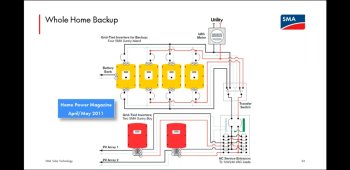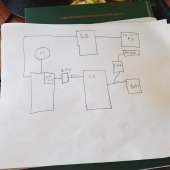Welcome to the Forum!
The following link lists compatibility for Sunny Boy use in grid-backup and strictly off-grid systems with Sunny Island.
Compared to previous version (which I don't find online any more), a couple inverters where changed regarding which applications work.
The series including 10000TLUS is no longer shown as compatible with grid-backup. The newer -40 and -41 models are now compatible with grid-backup.
A couple years ago, I bought old model 10000TLUS for that compatibility. In use, I found that while it didn't disconnect below 64 Hz, it didn't reduce output power so frequency kept swinging up until it disconnected. SMA support gave me the workaround of setting it in "offgrid" mode when used on-grid behind SI. They changed it in the updated list as no longer supported for grid-backup. (I would recommend not doing that unless you have and save a written message from SMA to do so, because it is not what documentation says. I envision possible failure modes presenting risk to utility linemen. I think the original scheme from SMA German engineers was failsafe.)
I'd like to hear from you guys as to your experience with various model SMA Sunny Boy on Sunny Island systems. I'm not seeing them respond properly to frequency shift in "Backup" (default = UL1741 & backup = On All Phases or On, depending on model and interface.) I'm only getting it to work in...

diysolarforum.com
I also asked a couple years ago about use of the newer -41 models for grid-backup, because nothing currently available from SMA was shown as compatible. Now, those are in the list. SMA has also put instructions in a video with different recommendations.
Various marketing and video material from SMA has said standard UL-1471 inverters could be backed up with Sunny Boy Storage or with Sunny Island. Those GT PV inverters wouldn't respond to frequency shift, would just connect and drop offline every 5 minutes, and battery would cycle. I don't think that is a good idea, might damage something in the inverters as well as wear battery.
The new recommendation for -40 and -41 model SB in the compatibility list is to use CA Rule 21 (needs to have frequency-watts feature enabled).
"SBxx-1SP-US-40 / SBxx-1SP-US-40 with CA Rule 21 For SBxx-1SP-US-40 / SBxx-1SP-US-40 with set country data set CA Rule 21, the Sunny Island is able to curtail the power of these PV inverters via frequency-shift power control (FSPC) without a RS485 communication link. PV inverters without backup mode
For PV inverters without backup mode, the country data set must be set to the locally typical value for grid-tie PV systems as per UL1741. The PV inverter is then configured for operation on the utility grid. In the event of a utility grid failure, the Sunny Island is unable to derate the PV inverters by means of Frequency-Shift Power Control (FSPC). If there is an excessive supply of energy, the PV inverters will switch off."
Standard UL-1741 had tight frequency and voltage limits. That would stay online for in-spec grid and disconnect for 5 minutes if out of spec.
UL-1741-SA without frequency-watts rides through minor voltage & frequency excursions and remains connected for 5 minutes, then disconnects.
UL-1741-SA with frequency-watts ramps down power with increasing frequency, something like 100% at 60.5 Hz to 0% at 61 Hz. I'm not sure the limits where it would disconnect for a period of time rather than just coming back immediately when frequency drops.
I believe this was a firmware update to -40 & -41 inverters. Other brand inverters can also work this way. (You want frequency-watts.)
SMA's off-grid setting (or "island") by default ramps down from 100% at 61 Hz to 0% at 62 Hz, but those can be changed. It remains connected up to 64 Hz, ready to respond immediately if frequency drops. Above 64 Hz, it disconnects for 5 minutes. This disconnect is used to knock SB offline so it doesn't deliver power while SI resynchronizes to grid. Wider voltage variation is also tolerated. This allows generator with looser regulation to be used.
The RS-485 cable with piggyback that fits older SB allows SI to tell SB when to switch from standard UL-1741 parameters to off-grid parameters. If grid deviates from standard tight specs, SI disconnects according to UL-1741 (it doesn't have UL-1741-SA, but I would expect new model to do that when European model gets modified for the U.S.)
Because SI disconnects grid, it would seem SB offgrid settings would be sufficient. Some SMA material (e.g. videos) have said to use that setting. My guess as to why original designers and written documentation differs is that grid relay could become welded shut. Sunny Island would not be able to disconnect from grid. It would simply not signal by RS-485 to switch to off-grid parameters, and so SB would obey UL-1741 and shut off. But if SB was set to off-grid rather than grid-backup, it would keep driving through relay into grid without performing UL-1741 anti-islanding.
It looks to me like any GT PV inverter including SB -40 & -41 should work fine with UL-1741-SA frequency-watts mode for on-grid and grid-backup. If used with a generator, poorer voltage and frequency regulation may cause the to disconnect at times.
Because I have a "grandfathered" system originally permitted with SB 2500US before UL-1741-SA, I don't have to install the newer -40 or -41 models. I bought 10000TLUS, then switched to 5000US, so I am able to use RS-485. That is the way to go (and you might lucky and find new in the box old stock) if your locality doesn't require the inverter to have the "grid support" features of UL-1741-SA.






